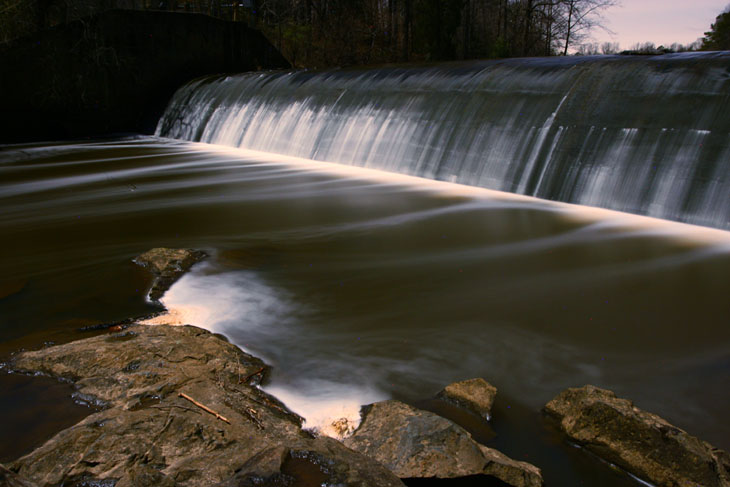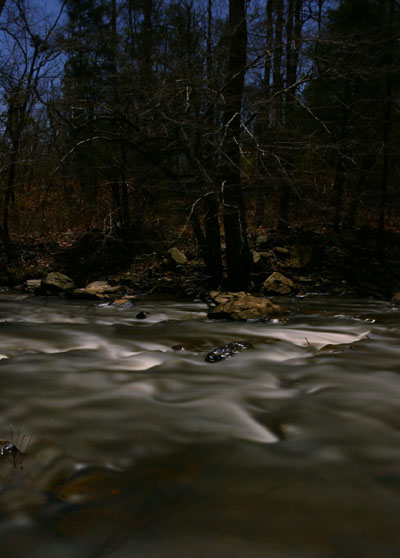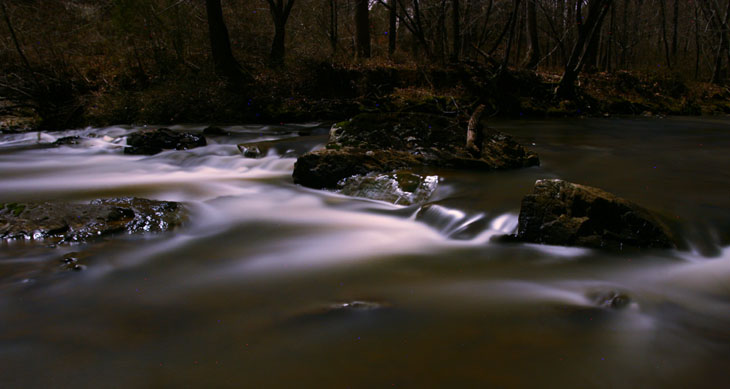[Repost of original posted January 5, 2015, destroyed by hosting failure.]

I have a lot of little things on a mental checklist to get images of, experiments to try, and items of that nature. It’s 2:30 am as I type this, having just come back from attempting one, the results you see here.
These are all moonlight shots. A low pressure system pushed through recently and brought a lot of rain and some pleasantly higher temperatures for this time of year, but as it passed so did all the clouds, letting tonight’s full moon shine down brightly. It was probably still about 14°c (58°f) with only a mild breeze, so not bad conditions for night photography at any time. I had returned to the river near the old house that we left last May, since it had the best elements for long exposures that can be accessed at that time of night; a few nearby parks on the same river (which is the Eno) might have been pretty good too, but there’s no entry past sundown.
 It’s funny how long it took me to get these, since you’d think I’d have the opportunity every full moon. But this also requires clear weather on those nights, a temperature comfortable enough for me to want to be out standing around waiting on the long exposure times, and both a sleep schedule and the desire to go out at midnight or so – these just hadn’t come together previously. If I remember right, a couple of previous occasions had been postponed because I had no readily-available headlamp, which has been rectified now – in fact, I got to try out two new lights, one of which a christmas present, and both worked quite well.
It’s funny how long it took me to get these, since you’d think I’d have the opportunity every full moon. But this also requires clear weather on those nights, a temperature comfortable enough for me to want to be out standing around waiting on the long exposure times, and both a sleep schedule and the desire to go out at midnight or so – these just hadn’t come together previously. If I remember right, a couple of previous occasions had been postponed because I had no readily-available headlamp, which has been rectified now – in fact, I got to try out two new lights, one of which a christmas present, and both worked quite well.
Over a year ago, I had ventured down to this location on a moonless night, and the number of wolf spiders that could be seen by their eye reflections was stunning – they were everywhere, all over the ground and weeds, up the treetrunks, and I’m pretty sure I even spotted one on a rock out in the river. Surprisingly, I saw quite a few tonight, taking immediate advantage of the warmer weather to go out and forage.
Now, I made a mistake tonight. I got spoiled with the Canon Elan IIe and the D-Reb, both of which can use the RC-1 infra-red remote to trigger time exposures on Bulb setting – one click to open the shutter, another to close. The RC-1 was always with me, dangling from the zipper-pull of the camera bag, so I never had to think about it. But the RC-1 does not work on the 30D that I used for these shots, and the TC-80N3 wired remote release was in another bag, which meant I had to hold my finger on the shutter button for the entire time during these exposures. This is not recommended – it’s very easy to shake the camera – and it prevented me from going for exposures longer than four minutes. Actually, I was just counting off the seconds in my head, and the camera and I disagree seriously on how long the exposures were; I had it down as (top to bottom) 240, 190, and 240 seconds, while the EXIF info tells me 183, 154, and 188 seconds. If I believed officer Frank Murphy (or perhaps it was Roy Scheider*,) this could be serious news for my mental stability, but I also think the camera tends to do a slow count.

With long enough exposures, moonlight can actually appear almost exactly like sunlight, except that anything that moves will be blurred, and you may even get star streaks in the sky. I wanted things a little darker, so I kept the exposure times shorter, but they were still plenty long enough for the rippling, splashing water to blur significantly – this is the same thing you would do for those gauzy waterfall photos, and some day, I’ll get some of those by moonlight as well (the nearest waterfall is probably 200 kilometers away, so not a trip that was going to happen tonight.) It’s important to have something unmoving in the photo for the juxtaposition, to appear nice and sharp, but it also helps to have better foreground interest and setting than what I have here.
But if you haven’t tried this, definitely add it to your own list, and be creative. You’ll almost certainly end up with something you like.
* Go watch the film Blue Thunder




















































